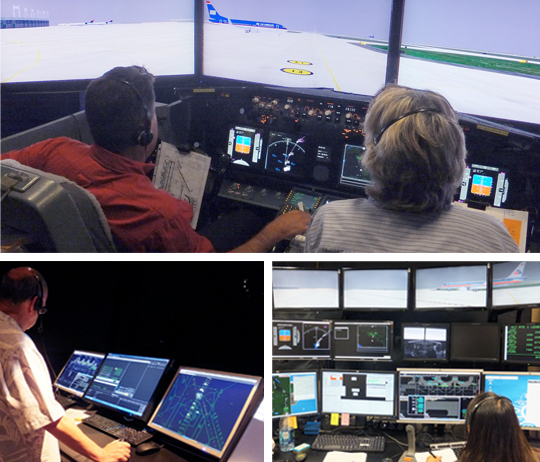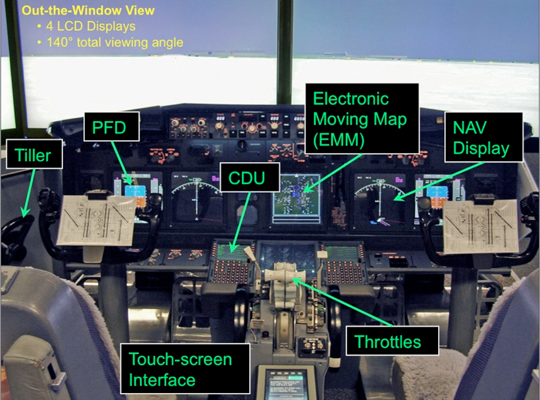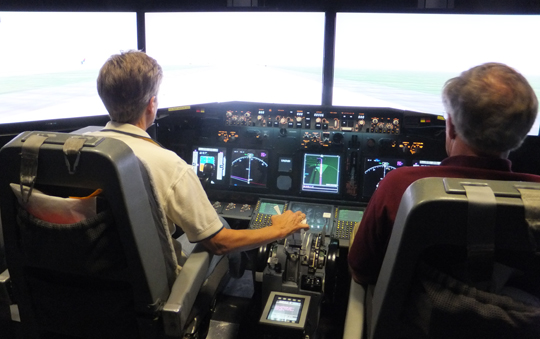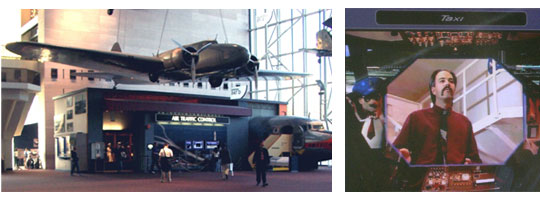|
|
 |

|
 |
 |
HCSL News
- ASIDE (ATAS-SARDA Integrated Departure Experiment) simulation completed
An integrated pilot and air traffic controller taxi simulation study was conducted in the Dallas/Fort Worth (DFW) environment. ATC Ground and Local Controllers in NASA’s Future Flight Central (FFC) air traffic control simulator used the Spot and Runway Departure Advisor (SARDA) decision support tool to plan and issue spot release clearances and departure clearances while commercial transport pilots taxiied from gate to departure runway in the Airport and Terminal Area Simulator (ATAS). The ATAS, a simulated B737NG with NextGen Surface Operations and Information Sharing Displays, was integrated into the realistic simulation traffic environment.
The objective of this simulation was to determine the stability and robustness of SARDA under realistic pilot/aircraft performance variation. Results indicated that under a variety of observed pilot/aircraft performance variations, SARDA yielded controller advisories that were: Supportive of current-day time-based operations; Compatible with controllers' expectations; Predictive of actual takeoff times; and, Adaptable to off-nominal events. The flight deck Information Sharing Displays that presented SARDA sequence and timing information to pilots, was considered useful for both NextGen operations and current-day time-based Traffic Management Initiative (TMI) operations.
This research was submitted and accepted for presentation/publication at HCI-AERO 2014, which was held in Santa Clara, CA on July, 2014.
 |
|
- International collaborations in Engineering Knowledge Capture and Communication Tools
The Human-Centered Systems Laboratory hosted two international summer visitors from Imperial College, London, Dr. Marco Aurisicchio and Dr. Robert Bracewell, to collaborate in the development of engineering knowledge capture and communication tools. Over the two-month visit, Dr. Becky Hooey and visitors Drs. Aurisicchio and Bracewell held briefings with 13 different groups -- across locations (NASA, NESC and JPL); and across domains/programs/directorates (Aero and space) -- all of which could benefit from using the knowledge capture techniques and tools that they have been using.
Four topics for research collaborations are being pursued:
- Requirements Management
- Design Rationale Capture
- Root Cause Analysis
- Functional Analysis Diagram (FAD) Modeling
A research paper resulting from this collaboration has been accepted for presentation/publication at HCI International 2014.
|
|
- ATAS (Airport and Terminal Area Simulator) completed
The Airport and Terminal Area Simulator (ATAS) development has been completed. ATAS simulates a B737NG aircraft with current-day avionics and can also be reconfigured to test advanced NextGen displays, technologies, and procedures.
Capabilities include two-pilot crew testing, realistic Flight Management Systems and Mode Control Panels, DataComm/Datalink, NextGen displays, custom scenario development and data collection tools. The focus of research includes integrated arrival, departure and surface (IADS) research.


|
|
- "Human Performance Modeling in Aviation" book available
 The book "Human Performance Modeling in Aviation" (David C. Foyle Becky L Hooey, Editors) is now available (CRC Press/Taylor & Francis, Publisher). This book describes and documents the recently completed Aviation Safety and Security Program (AvSSP) Human Performance Modeling project (Table of Contents - PDF 52KB, The book "Human Performance Modeling in Aviation" (David C. Foyle Becky L Hooey, Editors) is now available (CRC Press/Taylor & Francis, Publisher). This book describes and documents the recently completed Aviation Safety and Security Program (AvSSP) Human Performance Modeling project (Table of Contents - PDF 52KB,  Download Adobe Acrobat Reader). Download Adobe Acrobat Reader).
In this project, five teams from industry and academia modeled NASA-supplied data on two aviation problems: pilot surface operations taxi errors and approach and landing with synthetic vision systems. Chapters by Foyle and Hooey introduce the goals and context of the project, the NASA simulation data supplied, as well as integrate the results and implications of the project while addressing the future of human performance modeling in aviation. Principal authors of chapters on specific modeling efforts include: Air MIDAS (Kevin Corker, San Jose State University); D-OMAR (Stephen Deutsch and Richard Pew, BBN Technologies); ACT-R (Michael Byrne, Rice University and Alex Kirlik, University of Illinois); A-SA (Chris Wickens, University of Illinois); and, IMPRINT/ACT-R (Christian Lebiere, Micro Analysis & Design and Rick Archer, Alion Science & Techology).
The book also includes a chapter describing an analysis of cross-model capabilities, outcomes, and project validation approaches (Ken Leiden, Alion Science & Techology), and a "virtual roundtable" chapter in which a common set of probing questions are answered by the principal authors of each modeling team. The foreword was written by Richard Pew (BBN Technologies), a world-renowned expert in the field of human performance modeling in aviation, and project team member.
Foyle, D.C. & Hooey, B.L. (2008). Human Performance Modeling in Aviation. CRC Press/Taylor & Francis: Boca Raton, FL.
POC: David Foyle, Ph.D., David.C.Foyle@nasa.govand Becky Hooey, M.Sc., Becky.L.Hooey@nasa.gov, Human Systems Integration Division, Code TH
|
|
- T-NASA in the Smithsonian!
The T-NASA (Taxiway Navigation and Situation Awareness) system was on exhibit in 2005 at the Smithsonian National Air and Space Museum on the National Mall in Washington DC. The Edgarville Airport interactive virtual airport exhibit includes a 5-minute video clip describing T-NASA and contains interviews of NASA Ames researchers Dr. Dave Foyle and Dr. Rob McCann.

The exhibit is still on display as part of an interactive display on NASA aeronautics works called "Edgarville Airport" at the Ames Exploration Visitor Center.
Edgarville Exhibit in the Smithsonian National Air & Space Museum (Left), Dr. David Foyle in Edgarville Exhibit Video Clip (Right)
- Unlocking the Grid, PBS (2002)
T-NASA was featured in a 2002 PBS television documentary entitled "Unlocking the Grid". This one-hour educational television program addresses the complex reasons for increasing air traffic delays leading to gridlock at our nation's airports, and showcases advancing NASA/FAA technologies aimed at the improvement of ground capacity, efficiency and safety. One of the featured technologies was the Taxiway Navigation and Situation Awareness (T-NASA) System.
Click on the picture to view a video clip from the documentary including interviews with Dr. David Foyle, Dr. Tony Andre, Captain Dan Renfroe, and Captain Dale Finch discussing the T-NASA Head-Up Display and Electronic Moving Map and how they increase both taxi safety and efficiency.
![[view video]](images/foyle_papermap.jpg) (Click image to play QuickTime movie)
(Click image to play QuickTime movie)
HCSL Awards and Honors
"Best of Track" Award for Conference Paper
A recently presented conference paper by Becky Hooey (TH/San Jose State University Research Foundation) and David Foyle (TH) at the International Workshop on Managing Knowledge for Space Missions (Pasadena, CA; July 17-19) was named "Best Paper in the area of Applied Knowledge Capture and Reuse. The paper discussed system requirements for a design rationale capture tool that supports conceptual design, design implementation, and design evaluation and transfer. Design techniques to minimize the burden of knowledge capture and maximize benefits throughout the entire design lifecycle were presented.
Reference: Hooey, B. L. & Foyle, D. C. (2007). Requirements for a design knowledge capture tool to support NASA's Complex Systems. International Workshop on Managing Knowledge for Space Missions. Pasadena, CA (July 17-19, 2007). Available at: http://humanfactors.arc.nasa.gov/groups/hcsl/publications.php
POC(s): Becky Hooey, MSc, Ph.D. Cand., BHooey@mail.arc.nasa.gov, Ext. 4-2399.
NASA Group Achievement Award (2006)
The NASA Group Achievement Award was awarded to the System Level Integrated Concept (SLIC) Development Team for "successfully defining and developing revolutionary concepts to enable the desired growth for travel in the National Airspace System". HCSL staff received this award for efforts related to the development of future surface operations systems concepts in the Virtual Airspace Modeling and Simulation (VAMS) Project.
HCSL recipients: David C. Foyle, Anthony D. Andre
Digital Avionics System Conference (DASC) Best of Track (2000)
Awarded for the best paper in the Air Traffic Management Track at the 19th DASC.
"Integrating Datalink and Cockpit Display Technologies into Current and Future Taxi Operations"
Authors: Becky L. Hooey, David C. Foyle, Anthony D. Andre, and Bonny Parke.
> Download this paper (PDF),  Download Adobe Acrobat Reader Download Adobe Acrobat Reader
SAE Wright Brothers Memorial Award (1999)
Awarded to the best paper relating to the invention, development, design, construction or operation of an aircraft and/or spacecraft.
"An Evaluation of the Taxiway Navigation and Situation Awareness (T-NASA) System in High-Fidelity Simulation" (SAE Paper No. 985541):
Authors: Robert S. McCann, Becky L. Hooey, Bonny Parke, Anthony D. Andre, David C. Foyle, Barbara G. Kanki
> Download this paper (PDF),  Download Adobe Acrobat Reader Download Adobe Acrobat Reader
NASA Group Achievement Award (1998)
The NASA Group Achievement Award was awarded to the Low-Visibility Landing and Surface Operations Flight Validation Team "for significantly impacting the safety and efficiency of airport surface operations in all-weather conditions through development, integration, and demonstration of key navigation and situation awareness technologies". NASA's Low-Visibility Landing and Surface Operations (LVLASO) team successfully demonstrated, at Atlanta's Hartsfield International Airport, the integration of key airborne and ground technologies that enable more efficient and safer airport surface navigation and situation awareness during roll-out, turn-off and taxi operations in all visibilities. The Flight Validation Team's experimental system would significantly reduce the more than 20,000 hours of delay currently occurring at each of the 23 major U.S. airports and the 287 hazardous incursion reported in 1996.
Ames recipients included: David C. Foyle, Rose Ashford, Barbara Kanki, Anthony D. Andre, Robert S. McCann, Becky L. Hooey, David Graeber, Mikel Atkins, Dominic Wong, and Steve Elkins.
NASA "Turning Goals into Reality (TGIR)" Award (Global Civil Aviation), (Nominated October, 1998).
Each year, recognition is given to accomplishments that have been judged as the most outstanding contribution toward each of the Enterprise Goals and Objectives. In 1998, NASA Ames Center Director nominated the Taxiway Navigation and Situation Awareness System (T-NASA) Design/Development Team for this award.
|
|
|